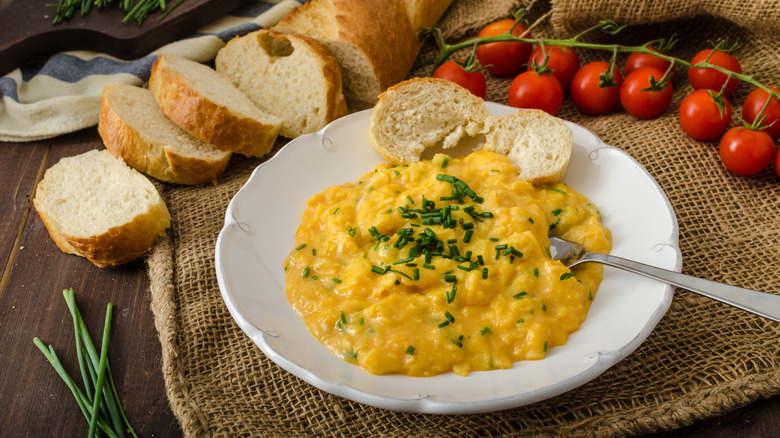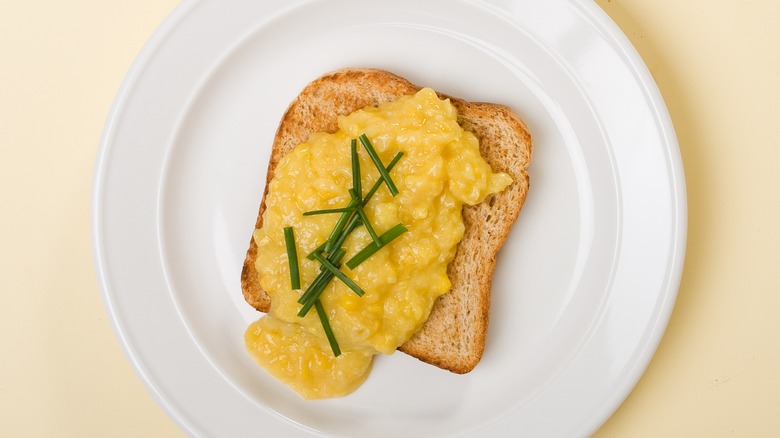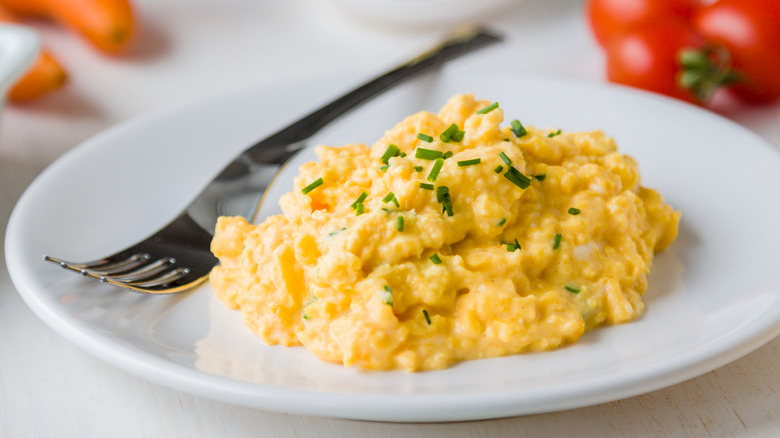How French Scrambled Eggs Differ From Soft Scrambled
The difference between French scrambled eggs and soft scrambled eggs may seem like a small concern, but in the world of eggs, minor distinctions make an outsized change in outcome. Starting from American diner-style hard scrambled eggs all the way down to the custardy French style, just one or two adjustments can turn the same few ingredients into an almost completely different meal. Even when the level of heat, cooking time, stirring method, and pan remain the same, a little tweak like mixing in salt before cooking your eggs can transform the texture into something much more soft. If salt alone can do that, just think what a bit of crème fraîche or a pat of butter could do.
Eggs are particularly sensitive to minor changes in heat and how they are handled, even with no added ingredients. American-style scrambled eggs, which are generally cooked faster over higher heat, have bigger curds with a firmer texture. As you move down the temperature ladder from there, the curds get smaller, the texture gets softer, and the eggs get creamier. If you are less familiar with the styles of scrambled eggs that are popular across Europe, the distinctions can start to get pretty granular. This is especially true for French-style scrambled eggs and soft scrambled eggs — terms that sometimes get used interchangeably. But there are some meaningful differences in how they are prepared as well as the final texture and taste.
What are French scrambled eggs?
French scrambled eggs are essentially the opposite of the U.S. diner-style version — to the point that some Americans might barely recognize them as scrambled eggs. The French style results in eggs that are so soft and creamy that they are almost a custard, with nearly imperceptible curds. Rather than getting a unified mass, the goal when making French scrambled eggs is to have lots of tiny curds, held together by a smooth, barely cooked "sauce" of beaten eggs. The finished dish is closer to polenta or grits than the hefty, distinct chunks you get from the American way. They also have a rich and decadent flavor, often accentuated by a slab of butter, and are best served as a topping for toast.
French-style scrambled eggs get their texture from a low-and-slow method of cooking that gradually sets the beaten eggs instead of immediately hardening them into curds. The eggs are poured into a cold pan and placed over low heat. Then, it's stirred continuously to prevent large curds from forming. In contrast to the spatula or wooden spoon you might use to mix your typical scrambled eggs, the French version is best done with a whisk. A whisk breaks up the eggs much more effectively and knocks out any gas and water vapor out of the scramble, resulting in that thicker, creamier texture. All of this is achieved without the use of milk or cream, although butter is sometimes added for flavor.
What are soft scrambled eggs?
Soft scrambled eggs are a little less clearly defined than the French variation. Directions on how to make them can vary based on who you listen to, but as a general definition, they occupy the middle ground between the custardy French style and the hard American style. For a soft scramble, your curds will be small and creamy but more defined than the nearly uniform and smooth French consistency. Soft scrambled eggs are also cooked a little harder, so they will lack the more liquid-like "sauce" that holds together the French-style eggs.
The preparation of soft scrambled eggs has some similarities to the French technique — the biggest one being temperature. Soft scrambled eggs should start in a cold or low-heat pan, and then be cooked slowly, although you can turn up the temperature a bit for this method. The two main differences will be how long you cook and how you stir. Instead of using a whisk to liquify the eggs, you can stick to a spatula to keep the egg curds a little larger as you stir. Beyond that, you want to cook the eggs a bit past where you would for the French version, driving out some of the excess moisture that could make your eggs more runny. Whichever style you prefer will come down to your own taste. Both are delicious, and if neither style is your cup of tea, there are always more ways to make scrambled eggs.


